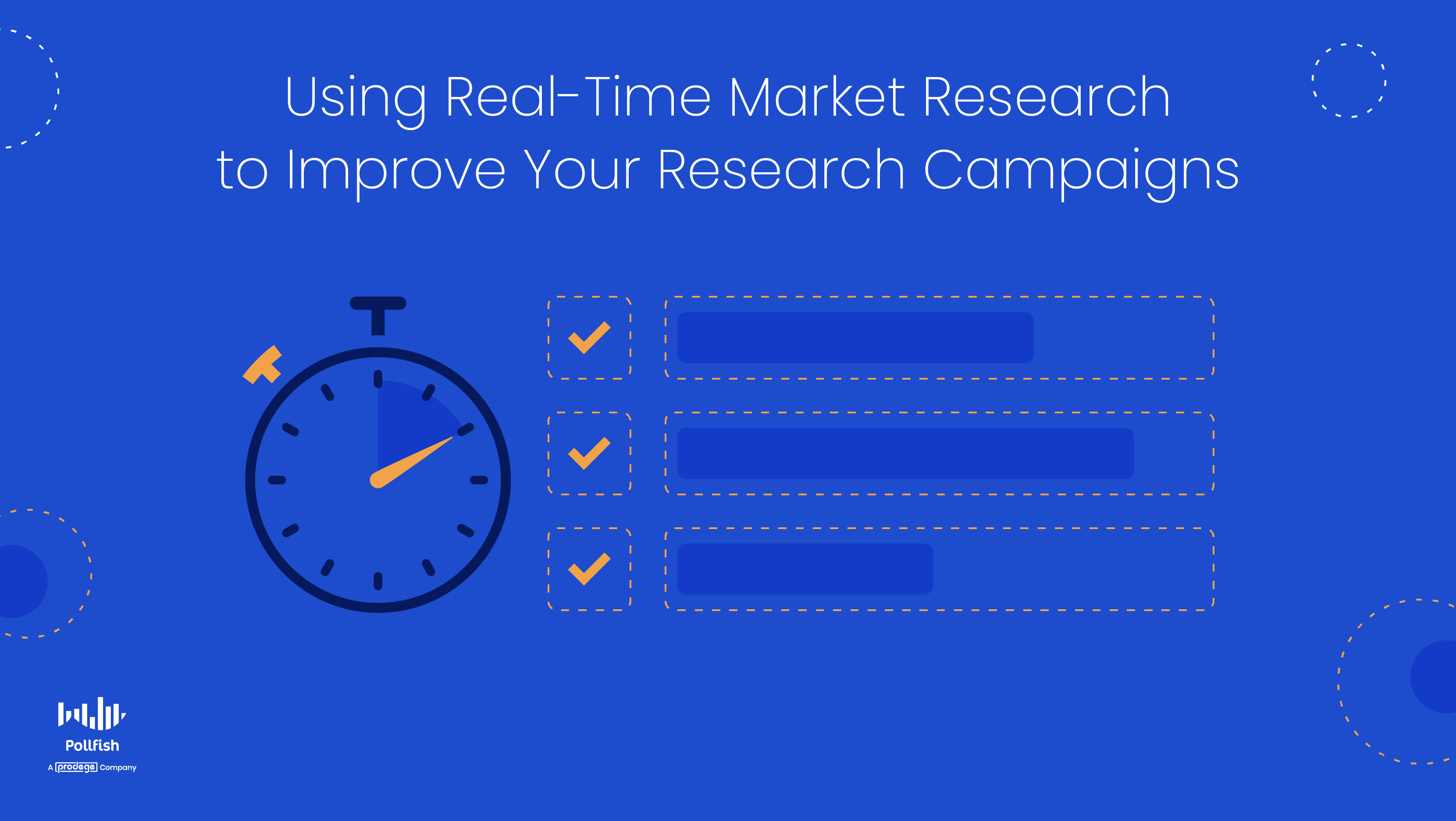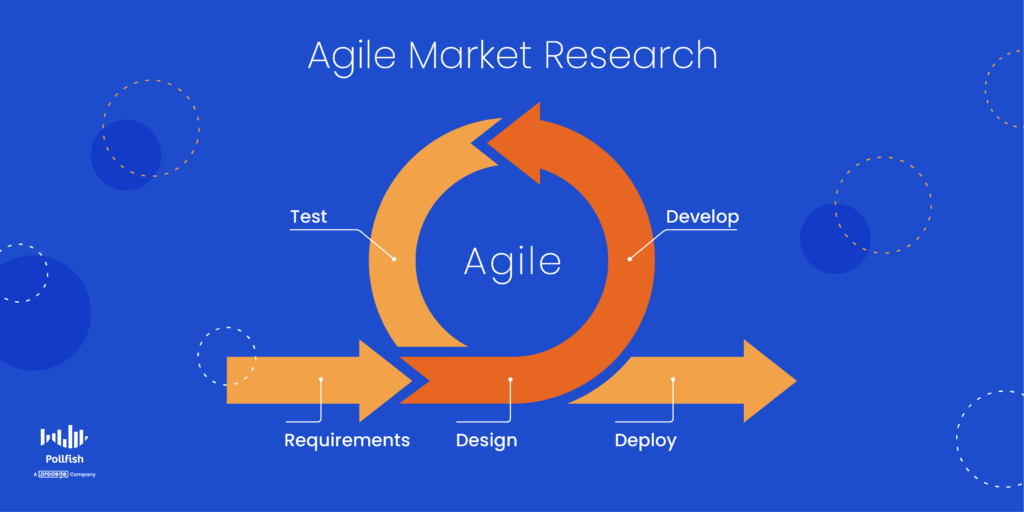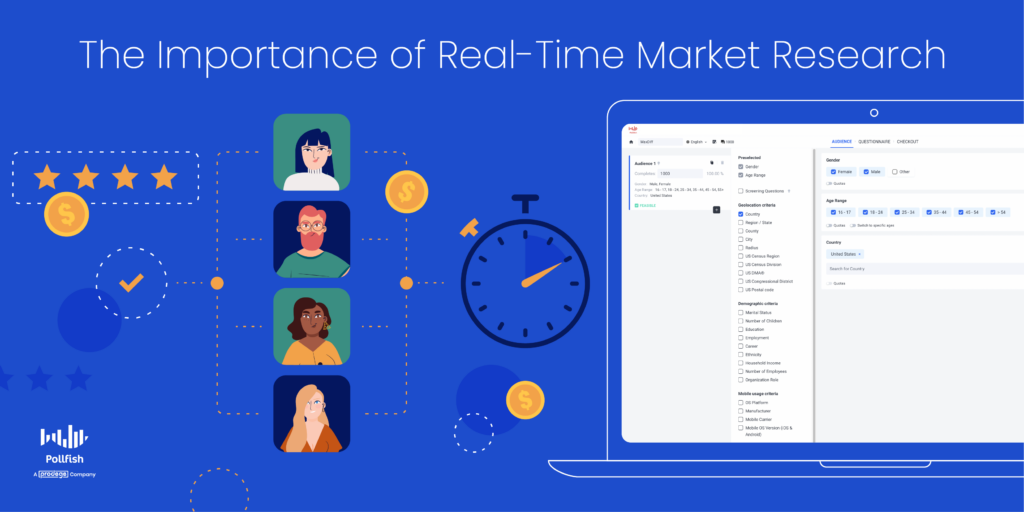Complete Your Real-Time Market Research with a Survey Platform

You may have come across real-time market research, a modern version of what essentially is ethnographic research.
That’s because businesses are constantly being swamped with different types of data collection methods — and software companies making all sorts of promises on the capabilities of their data.
This results in a kind of data overload: In 2022, 97.2% of businesses are investing in big data and AI. Despite this seemingly omnipresent investment, only 32% of businesses are able to realize tangible and measurable value from their data.
This rings true in market research as well, which provides a groundswell of data on customers and market trends. Among them is the said real-time market research.
Real-time market research is often part of the data advertised as necessary to businesses so that they can understand their customers. But this is not the same as real-time results data, despite the similarity in name.
Neither is it the same as survey research and other forms of agile market research.
However, it can be used in tandem with agile market research. The key is to do so correctly and to fully understand what real-time research entails.
This article lays out real-time research, how it’s conducted, its importance and how it can be used alongside agile market research, specifically survey studies campaigns.
Understanding Real-Time Market Research
As its name suggests, real-time market research is a kind of data collection method that garners information on customers in real time. This is to say that it involves collecting insights on customers’ experiences as they occur.
This may appear to be much like an ethnographic approach, which is a traditional market research method.
Ethnographic research is a kind of qualitative market research method for collecting data. In this method, data is collected through firsthand observations, which are then used to draw conclusions about customers.
Customers are thus observed in their natural environments rather than being interviewed after the fact.
These natural environments that customers frequent include:
- Malls
- Stores
- On the street
- Watching an advertisement
- While speaking or interacting with them
- Customer support sessions
- Digital environments (more on this in the real-time results research section below)
While it may seem to be outdated, it has been modernized in the form of real-time research, with different software companies offering tools for businesses to monitor their customers in the here and now.
Real-Time Market Research Vs Other Forms of Research
As you know, there is a plethora of research methods you can leverage for your studies.
Real-time is a form of research that should not be confused with other kinds, regardless of how similar in name they may sound, or how similar in function they may appear to one another.
There are a variety of legacy market research methods, such as snail mail surveys, telephone calls, in-person interviews and research panels.
However, for the purpose of this article, we’ll discuss how the real-time research approach differs from two major kinds of research: agile and real-time results research.
How Real-Time Differs from Agile Research
Real-time market research differs from agile research in that real-time is a method of collecting information by way of drawing data on a customer’s experience as it is happening.
As such, it is centered on customer experience and is therefore used to gain a clear understanding of customer reflections and their behaviors, as they’re manifesting them.
Agile market research, on the other hand, is a kind of research driven by iterative and incremental software development processes. It is predicated on getting insights on customer behaviors and sentiments, after they have occurred.

It is also different, in that it is also bent on rapid and flexible responses from respondents — these are often automated via software such as automated surveys. This agile method gives way to many benefits, such as faster time-to-market, low costs and improved quality of outputs.
Like many other kinds of market research, agile market research methods are primarily focused on forming statistics, while real-time research is based on data science.
As opposed to the reality of customer experience, the agile approach deals with the reflections of customers.
The biggest difference between these two forms of research is that in agile research, you would explicitly ask your respondents questions, while you wouldn’t in the real-time research method.
How Real-Time Differs from Real-Time Results Research
While they sound similar, these two forms of market research differ considerably. Interestingly enough though, real-time research can be a form of real-time results research.
First, let’s understand the core of real-time results research.
Real-time results research is a kind of research method in which customer data is collected in real-time.
However, unlike in real-time research, the real-time results method is based on data. Thus, the real-time results approach is focused on observing customers in the digital space, not in physical places.
The data becomes available as different data visualizations, which researchers can see being updated in real-time.
On the contrary, real-time research is driven by observing customer actions in the physical realm. It is therefore a modern version of ethnographic research since it also obtains information from consumers without explicitly asking them questions.
However, it too can apply to observing customer data in real-time. Thus, in this way, it is a form of real-time results research.
As such, it is easy to see why these two methods are often used hand in hand.
How to Conduct Real-Time Market Research
Real-time market research has evolved along with the broader market research industry. Gone are the days when the only way to conduct it was by watching customers in person or interacting with them (however, you can still use these methods as well).
The following is a list of the ways you can conduct this form of research:
- Social media listening
- Session replay tools
- Predictive analytics
- Field marketing
- Speaking and interacting with customers at trade shows, grand openings, etc
- Viewing how social media posts are engaged with
- Viewing how advertisements are engaged with
All in all, you can use any method of collecting data, as long as it gives you a firsthand glimpse into a customer’s experience as it is happening.
The Importance of Real-Time Market Research
This kind of research method is important on several accounts.
First off, it provides an alternative to agile methods of data for decision-making. This is important to researchers who seek to gather information on customer behavior as it exists at the moment rather than studying it retroactively.
This is also important, as it can be used as a comparison method to compare current behaviors and sentiments as they exist, with those of the past. In this way, it can be used for comparing the data from longitudinal studies.

In addition, this kind of research approach is critical to satisfying the need for a sharper understanding of customer reflections and behaviors. That’s because agile data can’t always capture everything, as some respondents forget things while others fall victim to selective memory.
Real-time research is also a must for client-side marketers who are in demand of immediate data, the kind they can access at any time of the day.
What’s more is that you can use it as a kind of real-time results research, by evaluating the performance of customers’ digital activities. They can do so via the tools mentioned in the prior section.
The greatest benefit of this kind of research is that it can be used in conjunction with agile market research, such as the kind you get from software such as survey platforms.
Using Survey Research with Real-Time Market Research
The ultimate verdict on real-time research is that it should never be a lone market research effort. Instead, it should be used in tandem with other forms of research, such as the aforementioned agile research.
Why? It’s simple. The insights you derive via the real-time method are far from sufficient.
They become truly invaluable, however, when you pair them with agile data. With both types of research in tow, you will be able to conduct an exhaustive research campaign.
That’s because these two forms of research complement each other. When you don’t have enough information from one, you can conduct the other type to make up for the gaps in insights.
For example, say you begin with real-time research. While the observations you made were interesting, they are likely to set off a bunch of questions in relation to the activities you watched. Thus, you would follow up with agile research, specifically via a survey campaign.
In this dual approach, you’ll get ethnographic research, coupled with answers to the questions that stemmed from it. Thus, you’ll have a full-picture understanding of the subjects you’re studying.
You can also compare real-time research with historical data or market trends. Much of this data can be conducted via the agile method as well, especially when it comes to longitudinal research.
In addition, you can also combine the agile and real-time methods via brand trackers.
These are ideal for uncovering seasonal and ongoing trends, unlike real-time, which shows you what’s occurring in the present.
Thus, you can compare the data from both for a strong understanding of your customers and how they feel about your business.
The final key takeaway is that real-time market research provides a key aspect of research on your consumers. But it should never be used on its own; it is best to use it to complement agile research, as automated surveys help fill the void in what a real-time campaign lacks.
Perfecting Your Research Needs
The real-time approach to market research can come in handy whenever you seek to study customer activities and behaviors as they are happening. This kind of research adds another facet to your survey studies.
You should always use it with agile research, particularly surveys, as surveys can uncover virtually anything, depending on the questions you use with it.
You should therefore select your platform carefully. A strong market research company will allow you to carry out and fulfill all of your market research activities.
We suggest using a survey platform that offers a wide range of capabilities and functionalities. This will ensure a valuable campaign that is rich in insights, as well as granting you ease of deployment and analysis.
Pollfish survey software allows you to create a thorough survey data collection, one you can customize to your liking, view however you choose and organize it to the max.
In addition, with our vast array of question types, you can create any type of online market research survey to support your research campaigns.
Researchers can leverage a wide pool of information on their respondents by accessing the data in their survey results dashboard.
When you have the support of such a market research platform, you can truly create multifaceted research experiences to inform all of your curiosities about your customers.
Pollfish Marketing Team
Ready to Try Pollfish?
Create your survey with AI, target high-quality respondents starting at $0.95 per complete, and start getting results in just minutes in real-time. From running a simple product concept survey to managing a constant stream of trackers for dozens of clients in dozens of countries, we’ve got you.
